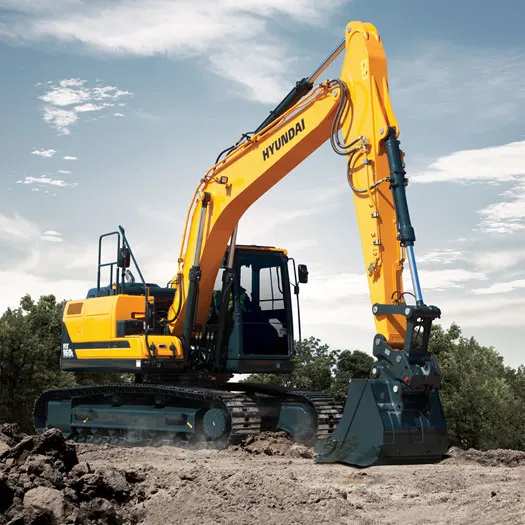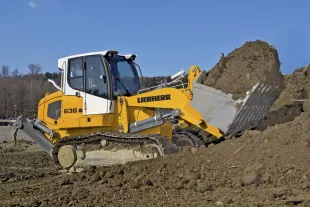The method of tunnel construction depends on such factors as the ground conditions, the groundwater conditions, the length and diameter of the tunnel drive, the depth of the tunnel, the logistics of supporting the tunnel excavation, the final use, and the shape of the tunnel and appropriate risk management. Tunnel construction is a subset of underground construction. The selection of the apt equipment therefore becomes pivotal.
Discussed below are some of the most used tunnel equipment used in construction.
Crawler Excavators
The modern crawler excavator is designed to dig or grade, or move earth and large objects, and is classified by its mode of locomotion. The many types of excavators include wheeled, walker, towed, and rail excavators. Related to tracked tanks widely used by armies, these crawlers move upon the same rotating wheel systems, but also have the ability to dig, pick and transport excavated materials as they proceed. The crawler excavator components include a major crawler chassis, rotor support, the central swivel joints, turntables, the device weight, the panel, cab, and air-conditioners. Hybrid crawler excavators comprise several features such as class-leading power output, stability, lifting capacity, and operator comfort. Two short-tail models deliver exceptional functionality for confined workspaces. All machines offer great fuel efficiency and performance. These equipment are used to create cross-tunnels when explosives are being used for secondary profiling, and, of course, for direct excavator tunneling.

HX160L Crawler Excavator
Wheel loaders
Newer wheel loader models are equipped with a 28.5 kilowatt / 38.8 engine as standard. The exhaust after-treatment is carried out by DOC and DPF. Smart Driving PRO is also optionally available for the all-wheel steer loader. This is a new feature with three different operating modes that support and relieve the operator in the respective applications whilst being fuel-efficient. In the Power Mode, the complete engine output is available. This provides an ideal basis for fast loading cycles and also for work in excavated material. In comparison to the Power Mode, the machine drives the same travel speed in Eco Mode with reduced engine speed. To reduce the noise level and to save fuel, this operator mode is above all suitable for stacking work in which the full system power is not required. Wheel loaders are specially designed for use in tunnel applications.

Wheel Loader WA475-10
Crawler loaders
New age crawler loaders deliver more horsepower than predecessors. Hydrostatic transmission offers Total Machine Control, which allows operators to choose between multiple settings: speed-in-grip and a V-pattern control with foot pedal steering. On-board hydrostatic and hydraulic pressure sensors provide operators with pressure readings via an in-cab monitor. Eco Mode optimizes fuel economy by up to 20 percent while maintaining ground speed by automatically adjusting engine speed and transmission settings based on the load. It functions in both forward and reverses directions. Auto idle lowers engine speed when the machine is not moving and no functions are being activated. An adjustable timer can be set in the monitor and coupled with auto-shutdown. Hydrostatic transmission offers operators to choose between multiple settings: speed-in-grip and a V-pattern control with foot pedal steering. On-board hydrostatic and hydraulic pressure sensors provide operators with pressure readings via an in-cab monitor. Operational specifications are configured with individual additional options to tailor the machines to tunnel applications and conditions.

Crawler loaders
Tunnel boring machine
A tunnel boring machine (TBM), is used to excavate tunnels with a circular cross-section through a variety of soil and rock strata. They may also be used for micro tunneling. They can be designed to bore through anything from hard rock to sand. Tunnel diameters can range from one metre (3.3 ft) (done with micro-TBMs) to 17.6 metres (58 ft) to date. Tunnels of less than a metre or so in diameter are typically done using trenchless construction methods or horizontal directional drilling rather than TBMs. TBMs can also be designed to excavate non-circular tunnels, including u-shaped or horseshoe and square or rectangular tunnels. From standstill to high speed – the control modules of latest models enable users to optimally control a wide range of speeds. The combination of two-speed motors and the ability to use motors in tandem in free circulation sets new standards about performance and power. With their compact design, the self-rotating cutter heads can drill even through the hardest rock layers.

“Alice” the Tunnel Boring Machine
Horizontal Directional Drilling Machines
Horizontal Directional Drilling Machines (HDD) machines are steerable, trenchless drilling rigs for the installation of pipes, conduits, and cables underground in a shallow arc. They are commonly used for installations below waterways and roadways to avoid disturbing the ground above. Horizontal drilling machines are typically heavy-duty vehicles fitted with track drives, operator controls, and drilling machinery. Materials used for pipes include PVC, polyethylene, polypropylene, ductile iron, and steel. Directional drilling machines come in a range of sizes, with the largest machines capable of drilling to depths of 200 ft. and lengths of 6,000 ft. Horizontal directional drilling machines are divided into three categories: large-diameter HDD (maxi-HDD), medium-diameter HDD (midi-HDD), and small-diameter HDD (mini-HDD). There is no significant difference in the operation of these systems. The categories represent the drive length, depth, torque and pullback capabilities of each system.

Horizontal Directional Drilling
Immersed tube
An immersed tube is a kind of undersea tunnel composed of segments, constructed elsewhere and floated to the tunnel site to be sunk into place and then linked together. They are commonly used for road and rail crossings of rivers, estuaries, and sea channels/harbours. Immersed tubes are often used in conjunction with other forms of the tunnel at their ends, such as a cut and cover or bored tunnel, which is usually necessary to continue the tunnel from near the water’s edge to the entrance (portal) at the land surface. The main advantage of an immersed tube is that they can be considerably more cost-effective than alternative options – i.e., a bored tunnel beneath the water being crossed (if indeed this is possible at all due to other factors such as the geology and seismic activity.

Image Source: hyundai-ce.eu, komatsu.eu, liebherr.com, tranbc.ca, hanginghco.com, tunneltalk.com

